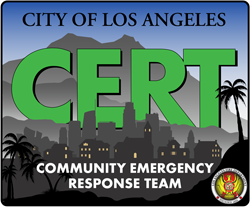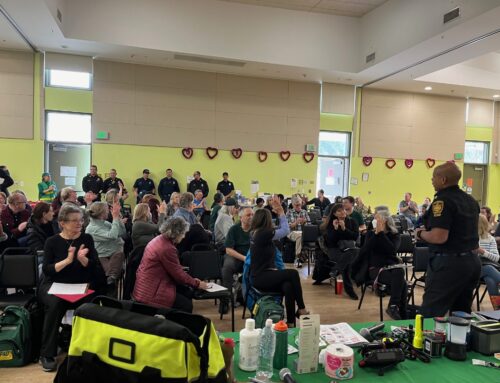An LAFD Incident Safety Officer is a senior member of the Command Team on incidents. Their job is to ensure scene safety by foretelling unsafe scenarios, conditions, and behaviors before they take place. Their job commences the moment they’re assigned as Safety Officer to the stop of the incident clock, including overhaul. They are constantly weighing the risk of the action versus what will be gained by that action.
Walk the concrete halls of the LAFD Frank Hotchkin Memorial Training Center, a stout monster of a building, and you’ll encounter walls lined with fire incidents captured on camera: networks of hose lines strewn about in the middle of columns of apparatus surrounding buildings as black and white billowy smoke erupt from windows and vents. Daring offensive operations depicting black scarred turnouts, feet from glowing infernos as yellow and orange helmeted figures mount aggressive fire attacks from street level doorways and neighboring rooftops. Scenes of defensive operations from aerial ladders as they pencil water streams into gaping holes of buildings and surround and drown a fire. I never get tired of reviewing these prolific acts sealed in flattened glossy shots. Be it color or black and white stills, all depict highly charged events of Firefighters putting the wet stuff on the red stuff. In addition to these hero-worshiping images, there’s a sobering saying, written in bold red letters that reads, “We will risk a lot to save a lot. We will risk a little to save a little.” As a Fire Safety Officer, I imagine this is the mantra they carry as they try to assess each risk and its gain.
I often think about this when I’m on scene for Call-Out duty. Whether it’s a major emergency structure fire, an extended brush fire campaign, or even a time-consuming haul of sitting on wires down. Scene safety is paramount, and we must be able to predict unsafe actions, conditions, and behaviors to ensure we as CERT members avoid being injured or worse.
Recently, our CERT Team provided hydration on a greater alarm fire in South LA. A few hours after our duties had finished, the Boyd fire erupted downtown, not far from where we had been deployed earlier. There was a massive explosion on the Boyd Fire and eleven Firefighters were seriously injured when they made their escape off the roof via an aerial ladder. It was a terrible event, and it shook me.
I replayed our earlier deployment: arriving on scene, carting the CERT cooler around, handing out drinks, collecting discarded bottles. I wasn’t thinking about our safety. Sure, I knew enough to wear my mask as the building reignited and thick acrid smoke snaked its way across the street near our staging area. I looked both ways before moving about the scene, knowing they had just brought in heavy demolition apparatus to pull the building apart limb by limb. I cautioned Firefighters from reaching into the cooler to grab a drink and insisted we do it for them so as not to contaminate the ice or other bottles. But I took it for granted it would start and end like so many other uneventful Call-Outs. The Boyd Fire was a powerful wakeup call and reminder for me. Whether CERT is on duty for hydration, brush fires, wires down, or patrols, each incident has its risks. Being unaware or too comfortable with the conditions or with our behaviors can have serious consequences.
After the Boyd Fire, I was at a brush fire and I watched as a CERT member followed an LAFD Firefighter as he ascended a hill with more than 10% grade. The Firefighter struggled not only with the steep rugged terrain, but with a CERT cooler as he hauled it to the top of the hill, our CERT member not far behind. Not only did the CERT member leave the safety zone and go into an area that still had fuel to burn, but Firefighters were still putting out hot spots on a burn scarred hill nearby. I used my FRS radio to direct the CERT member down off the hill, but he couldn’t hear my call due to the racket of the fire fight. Finally, I waved him down off the precipitous incline. He immediately complied and afterward explained that he was following the Firefighter up the hill so he could retrieve the cooler after the Firefighter handed out drinks to his crew. As I watched this CERT member, who no doubt had the best intentions, I weighed the behavior of entering a threat zone on a steep incline to retrieve a cooler and determined the risk was not worth the gain. Unknowingly, I stepped into that safety role that day.
Perhaps CERT could incorporate a safety lead on scene at future deployments, sizing up incidents and pointing out potential safety hazards. They could determine how close we stage our hydration pop-up tent to a structure on fire, highlight tripping hazards from the maze of hose lines and point out a clear path to take to avoid these impediments. Or direct the CERT Team’s attention to the ingress and egress of large demolition and fire apparatus as they enter and exit the incident. A Safety Team Lead could keep tabs on unsafe behaviors, like proper PPE implementation or even giving the “all clear” to check-in with the Incident Commander upon our arrival.
Most safety protocols and procedures are common sense. I don’t think you’ll ever witness a CERT Member man a hose line and run into a burning building. But, from my experience as a CERT member, we are susceptible to having blinders on. We can get so focused and comfortable with performing our tasks that we can lose sight of the risks that are possible on incidents.
I experienced this state firsthand when we encountered a Still Alarm over the 4th of July. On our way to get briefed by the Battalion 5 Chief at Fire Station 27, my CERT Partner, Emmanuela, and I heard and then saw the aftermath of a pedestrian being hit by a car in the middle of Hollywood Blvd. The first words out of my mouth was, “Oh my God, oh my God.” I repeated this a few times as I watched the pedestrian’s head bob up and down off the pavement from my sideview mirror. They looked as if they were having a seizure. After my initial shock, I went into action, calling Fire Dispatch and giving them a description of what we had on scene. A few seconds later, we lit up our light bar on CE27, hung a U-turn, and parked. As we left the suburban, Emmanuela, threw a pair of gloves at me for PPE protection and I tossed her a high visibility vest because we were heading into the middle of the street. Working as a team, we had covered each other’s “blind spot.”
As we made our way toward the patient, there was a lot to size-up, most notably the crowd that was forming and angrily vocalizing that we were taking too long helping the downed pedestrian. Obviously, the throng didn’t know we weren’t Firefighters, nor that we couldn’t render medical aid. This lack of knowledge only added to the intensity of the situation. It also didn’t help that someone was using their phone to film our every move.
As I struggled to don my high visibility vest (HVV), something I should have done the moment I got behind the wheel, I stationed myself in the middle of Hollywood Blvd to direct the flow of traffic. A myriad of scene nuances ran through me at a rapid pace. My amazingly effective CERT Partner checked on the patient as she calmed the crowd, reassuring them that help was coming. I remember looking for her amid the uneasy on-lookers and being worried about her safety. Fresh in my thoughts were the civil protests that had taken place only a month or so prior and the angry temperament by some was still with me. The moment I exited the vehicle after calling Fire Dispatch, I had forfeited an immediate link to them because our hand-held radios were set to a different tac channel. I ended up calling our Captain on my phone and giving him an update on our situation. Within minutes Engine 27 and Rescue Ambulance 27 barreled toward us from the west. As soon as they arrived on scene, they thanked us as they set down orange traffic cones to protect the area around their operations. I can’t speak for Emmanuela, but I had to gather up my wits and tamp down the adrenaline that had wreaked havoc on my nerves before I could drive away and head toward our original destination.
It was a dynamic situation, an experience I won’t soon forget. It has added a new level of awareness to my CERT response toolbox. One of my first instructions that has become the foundation of my CERT education over the last twelve years was fire extinguisher training: pulling the pin, aiming, squeezing, and sweeping a fire. All the while your partner is behind you, sizing-up the big picture, their hand on your shoulder, guiding you out and into safety. I look forward to adding more of these experiences to my repertoire.
By Jacqueline Kozak


